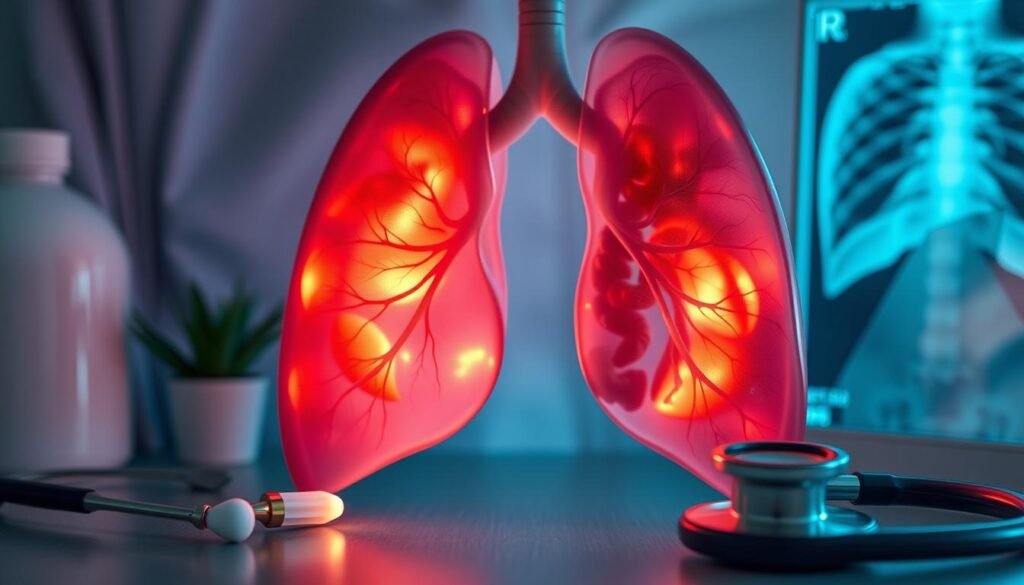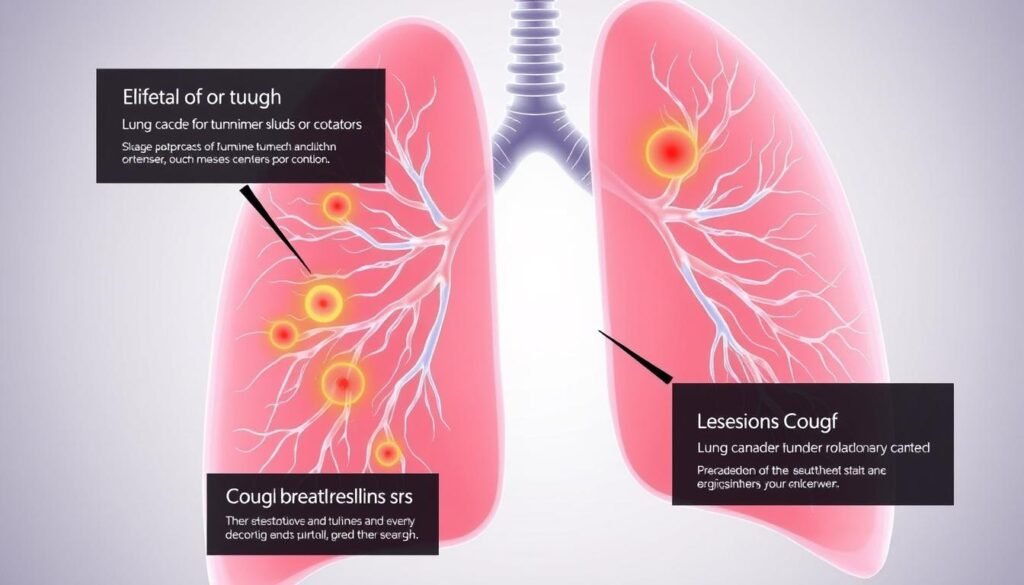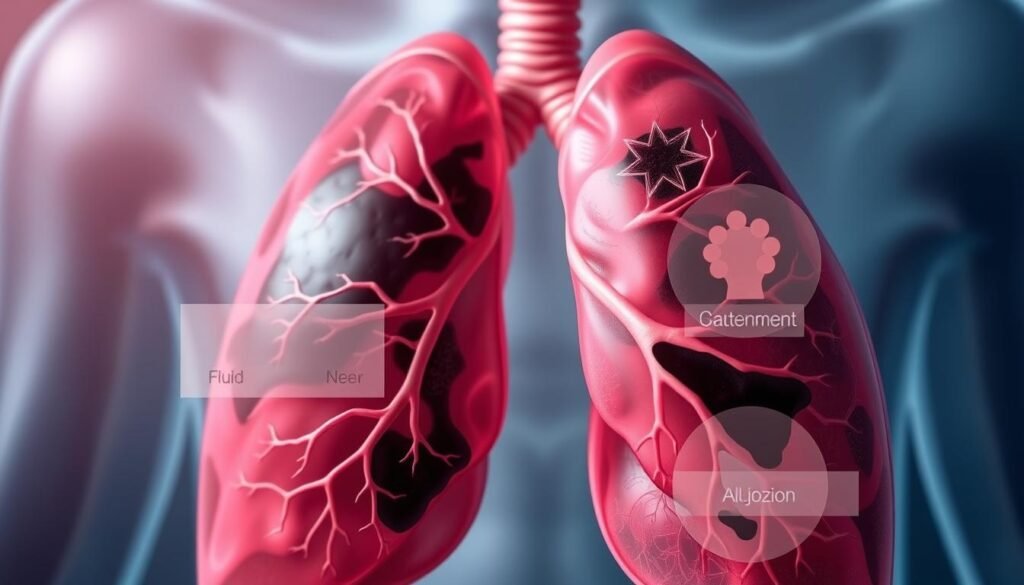Lung cancer is the top cause of cancer deaths around the world. It takes more lives than breast, prostate, and colorectal cancers combined. Many people don’t know the critical warning signs of this disease.
Early lung cancer signs often go unnoticed. Knowing the symptoms is key for early help and possibly saving lives. This guide will help you recognize lung cancer symptoms. It aims to increase knowledge on this important health issue.
Key Takeaways
- Lung cancer is the primary cause of cancer-related deaths globally.
- Identifying lung cancer symptoms can lead to earlier detection and treatment.
- Common early symptoms of lung cancer include chronic cough and shortness of breath.
- Understanding lung cancer warning signs empowers individuals to seek medical advice sooner.
- A thorough lung cancer symptoms checklist can aid awareness and proactive health measures.
Understanding Lung Cancer
Lung cancer starts when cells in the lungs grow out of control. This forms tumors that harm lung health. Tumors can spread to nearby tissues and other body parts, causing widespread cancer. Smoking is the leading cause of lung cancer, responsible for most deaths. However, non-smokers can also get lung cancer, which shows the need for awareness.
Several factors increase lung cancer risk, like radon exposure linked to 20,000 deaths a year. Being around asbestos, uranium, and certain oils also raises the risk. Knowing these risks helps understand how lung cells can grow uncontrollably.
Common lung cancer symptoms include a long-lasting cough and a hoarse voice. You might feel chest pain or find it hard to breathe. Some people feel very tired, lose weight without trying, or have seizures when the cancer is advanced. Recognizing these signs early is key to fighting lung cancer effectively.
Screening is crucial for those at high risk of lung cancer. Tests like sputum cytology and low-dose CT scans can catch cancer early. Early detection can reduce mortality by 20%, saving lives. It’s important to know about lung cancer and its effects on health. For more information, visit the Lung Cancer resource page.
The Importance of Early Detection
Finding lung cancer early is key to getting better treatment options and boosting survival rates. Lung cancer is really common and leads to the most cancer deaths in the U.S. Knowing the early signs of lung cancer is crucial. But, people often miss these signs, thinking they’re just regular breathing problems. This mistake can make treatment start too late.
Getting checked every year with a low-dose CT scan is a good way to catch lung cancer early. These scans spot unusual areas in the lungs that might be cancer. The American Cancer Society suggests these scans for folks from 50 to 80 who smoke or used to smoke a lot. For example, someone who smoked a pack a day for 20 years needs to get screened.

Early testing helps find lung cancer when it’s still in one place, which makes treatment more likely to work. Sadly, only 21% of lung cancer cases are caught this early. The low-dose CT scan is a great tool to cut down death rates and make life better for people. If you’re at high risk for lung cancer, talk to your doctor about getting screened and quitting smoking.
Common Lung Cancer Symptoms
Lung cancer ranks as the second most common cancer in the United States. Sadly, it’s often unnoticed until it’s quite advanced. This is because early signs can be subtle. Knowing the signs early on is key to getting help soon. Having a checklist for lung cancer symptoms is a smart move.
A chronic cough that won’t go away
A persistent cough can be a red flag. It’s serious if the cough lasts more than eight weeks. This demands a doctor’s visit. People might mistake it for allergies or bronchitis. So, understanding this is crucial in pinpointing lung cancer early.
Coughing up blood or rust-colored sputum
Seeing blood when you cough is alarming. It often points to lung cancer and calls for a doctor’s opinion. If there’s rust-colored sputum, it might mean bleeding inside the lungs. This symptom is a major alert on the lung cancer checklist.
Chest pain that worsens with deep breaths
Chest pain that gets worse when you breathe deeply or cough is a concern. It could mean the tumor is pressing on nerves or tissues. Catching these signs is crucial. They affect life quality and hint at serious health issues.
| Symptom | Details |
|---|---|
| Chronic cough | Lasts longer than eight weeks; warrants attention. |
| Coughing up blood | Can occur in small amounts; serious symptom. |
| Chest pain | Worsens with deep breaths; may indicate tumor pressure. |
Early recognition of these symptoms can lead to quicker diagnoses. This might improve chances for people at risk of lung cancer.
Identifying Lung Cancer Symptoms: Key Indicators
Knowing the early signs of lung cancer is key for catching it early. Often, people might miss these symptoms. Spotting lung cancer warning signs early can change the outcome greatly. For example, having trouble breathing and wheezing are big alerts that something might be wrong with your lungs.
Shortness of breath and wheezing
Many with lung cancer feel short of breath, known as dyspnea. Or, they might wheeze. This usually happens when airways are blocked or fluid builds up around the lungs. About 45% of people have this issue when they find out they have lung cancer. It’s a clear sign to get checked out by a doctor.
Hoarseness and unexplained weight loss
Hoarseness can start if lung cancer affects your vocal cords’ nerves. Then, there’s unexpected weight loss, seen in roughly 36% of patients at diagnosis. Together, they are critical signs of lung cancer. Spotting them early can really help in starting the right treatment sooner.

| Indicator | Percentage of Patients Reporting |
|---|---|
| Shortness of breath (dyspnea) | 45% |
| Hoarseness | Varies by type |
| Unexplained weight loss | 36% |
Fast action on these lung cancer warning signs is critical. Especially for those at higher risk, like smokers. Seeing a doctor right away is important. Early detection makes treatment more likely to succeed.
Signs and Symptoms of Advanced Lung Cancer
When lung cancer advances, people may notice different symptoms. These indicate the cancer has progressed. Knowing these signs helps with early action, improving chances of recovery.
Bone pain and headaches
Patients often feel bone pain and have headaches. These late-stage lung cancer symptoms might mean the cancer has spread. Early recognition of these symptoms is key. It leads to necessary tests and understanding the cancer’s reach.
Loss of appetite and fatigue
It’s common to lose interest in food and feel very tired. These signs of advanced lung cancer can lead to losing weight without trying. This affects health badly. Even with enough sleep, patients might still feel exhausted. This can make treatment harder. If you notice these signs, seeing a doctor quickly is critical. Learn more about spotting these symptoms in guides like this one.

The Role of Risk Factors in Lung Cancer
Lung cancer is a major health issue. It is closely linked with different risk factors. Smoking is the biggest cause, being behind up to 90 percent of cases. This fact shows that smokers are 15 to 30 times more likely to get lung cancer than non-smokers.
Environmental toxins also play a big part in lung cancer. Radon gas is the second main cause of lung cancer in the U.S. It mostly affects people living in areas with high radon. Another big risk comes from asbestos. Workers exposed to asbestos have a much higher lung cancer risk, which increases if they smoke.
It’s important to understand these risk factors to prevent lung cancer. Secondhand smoke exposure at work or home puts you at more risk. Also, having had radiation therapy in the chest area makes lung cancer more likely, especially in smokers.
Below is a detailed summary of lung cancer risk factors:
| Risk Factor | Details |
|---|---|
| Smoking | Causes 80-90% of lung cancer deaths; increases risk significantly. |
| Secondhand Smoke | Increases risk for non-smokers exposed to cigarette smoke. |
| Radon Exposure | Second-leading cause in the US; linked to home and workplace exposure. |
| Asbestos | High risk for workers; exacerbates effects of smoking. |
| Previous Radiation Therapy | Increased risk of lung cancer, especially for smokers. |
| Family History | Can double or even higher risk of developing lung cancer. |
| Environmental Pollutants | Dime exhaust and other pollutants contribute to a small percentage of lung cancer deaths. |
How Lung Cancer is Diagnosed
Lung cancer diagnosis starts with various tests. Early and accurate detection is key for effective treatment. The first step usually involves a chest X-ray. But, it might not always confirm lung cancer. It can’t always tell the difference between cancerous and non-cancerous conditions.
After an X-ray, doctors often suggest a CT scan. This scan gives clearer images of the lungs. It helps spot any abnormalities.
Imaging tests and biopsies
If a CT scan shows signs of cancer, PET-CT scans are next. These scans detect active cancer cells. They help decide the next steps in diagnosis. If the CT scan sees cancer in the central chest, a bronchoscopy is crucial. It lets doctors get cell samples from the lungs.
An endobronchial ultrasound may be used for more in-depth checks. It combines bronchoscopy with ultrasound. Depending on the case, various types of biopsies like thoracoscopy and mediastinoscopy might be used. These methods are effective but come with small risks, such as pneumothorax.
The TNM staging system is crucial for understanding lung cancer’s extent. It looks at the tumor’s size (T), spread to lymph nodes (N), and if it has spread further (M). Knowing the exact stage of lung cancer helps in choosing the best treatment.
To sum up, diagnosing lung cancer involves imaging tests and biopsies. For deeper insights into lung cancer diagnostics, check this comprehensive guide.
Distinguishing Between Lung Cancer Types
Lung cancer has two main types: small cell and non-small cell. Knowing the difference is key for treatment and care.
Small cell lung cancer vs non-small cell lung cancer
Small cell lung cancer (SCLC) makes up about 15 to 20% of all cases. It’s aggressive and usually linked to smoking. On the other hand, non-small cell lung cancer (NSCLC) is more common, making up 80 to 85% of cases.
NSCLC includes adenocarcinoma, squamous cell carcinoma, and large cell carcinoma. Adenocarcinoma starts in mucus-producing cells. Squamous cell carcinoma begins in the flat cells lining the airways, usually in the center of the lungs. Large cell carcinoma has unusually big cancer cells when looked at through a microscope.
Other less common NSCLC types are adenosquamous carcinoma and sarcomatoid carcinoma. These may look unusual under a microscope. Rare lung tumors like salivary gland type tumors and lung sarcoma need different treatments. It’s important to know the type for the right treatment. Secondary lung cancers come from other parts of the body but are treated similarly.
For more about lung cancer types and treatments, visit the American Cancer Society. This info helps doctors and patients handle lung cancer better.
| Type of Lung Cancer | Percentage of Cases | Main Characteristics |
|---|---|---|
| Small Cell Lung Cancer (SCLC) | 15-20% | Aggressive; often linked to smoking |
| Non-Small Cell Lung Cancer (NSCLC) | 80-85% | Includes adenocarcinoma, squamous cell carcinoma, and large cell carcinoma |
| Adenocarcinoma | Most common NSCLC subtype | Originates in mucus-producing cells |
| Squamous Cell Carcinoma | Occurs centrally in the lungs | Forms in flat airway surface cells |
| Large Cell Carcinoma | Defined by larger cancer cells | Can occur in any area of the lung |
Asking the right questions about treatment is crucial. Resources like key questions for oncologists help patients make informed choices.
Recognizing Lung Cancer Symptoms in Different Demographics
Lung cancer affects different groups in unique ways, mainly due to their demographics. The symptoms vary based on age, sex, and ethnicity. Men see more lung cancer cases than women. Women often face unique lung cancer types, showing different symptoms early on.
African American men have a higher risk than others. This fact highlights the need for focused education and prevention in their community. Spotting lung cancer early in both men and women improves chances for better health outcomes.
Early lung cancer signs are sometimes overlooked as common respiratory problems. This can delay getting the right help. Knowing what symptoms look like in each group helps catch cancer sooner. Screening those at risk early can save lives by finding lung cancer early.
| Demographic Factors | Prevalence | Common Symptoms |
|---|---|---|
| Men | Higher rates of lung cancer | Cough, hemoptysis, weight loss |
| Women | Diagnosed at a younger age | Shortness of breath, fatigue |
| African American Men | Increased risk of lung cancer | Chest pain, lymphadenopathy |
| Hispanic Women | Lower incidence rates | Persistent cough, headaches |
Conclusion
Lung cancer is a major health issue, being the third most common and the deadliest cancer in the US. About 80% to 85% of lung cancers are non-small cell lung cancer (NSCLC). Spotting symptoms early can make a big difference. For example, early-stage NSCLC has a 65% chance of survival over five years. But late-stage cases have a grim outlook. This highlights how crucial awareness of lung cancer is.
It’s vital to teach people about lung cancer’s symptoms, risks, and when to get screened. If you’re 50 to 80 years old and have smoked a lot, you should get checked regularly. Knowing the symptoms helps people seek help sooner. Plus, it helps doctors give the right advice and treatment. Talking more about lung cancer and taking your health seriously can lead to better results for patients.
The effects of lung cancer go beyond the patient, touching families and entire communities. By building a culture that understands and recognizes lung cancer, we can lower the number of cases. We can also improve life for those affected. Working together, we aim for a future where lung cancer is caught early, treated well, and better understood by all.